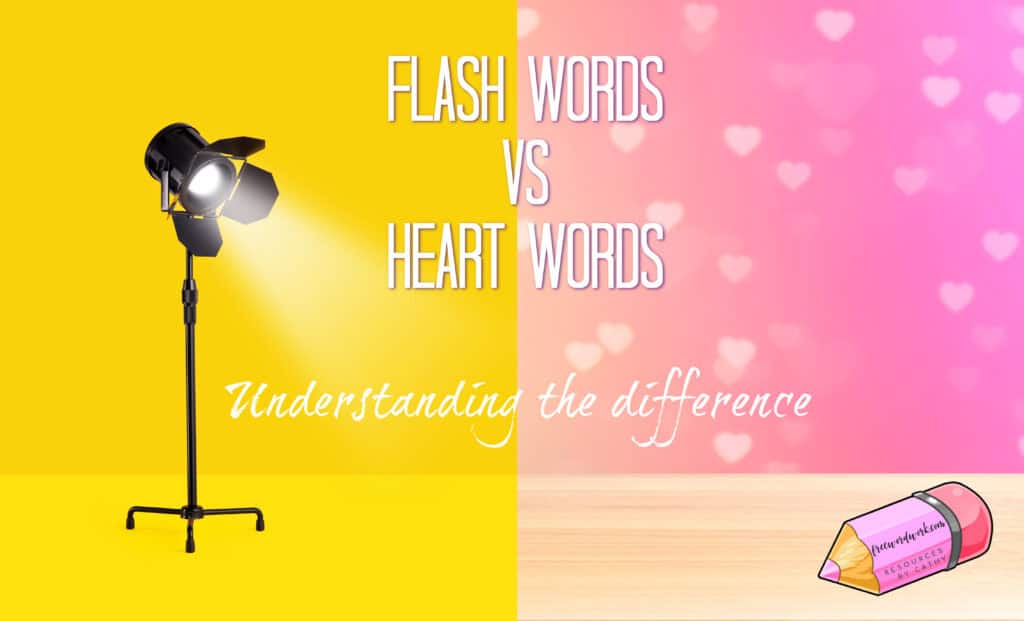Flash Words versus Heart Words: An Introduction for Teachers
One of my summer goals is to learn more about the Science of Reading. Not only do I want to develop a better understanding, I also want to find ways to make this learning applicable to my 6th grade classroom.
As part of this process, I am going through different on-line classes, reading, and listening to others share what they are doing.
Below my goal is to explain what I have come to understand about flash words and heart words.

Sight Word Materials
In my second-grade classroom, I found ways to help my struggling readers build a larger sight word vocabulary. As I am learning about SOR, I am trying to look at my past approaches and find ways those should change in order to better align with what we know about reading.
I know that not all districts are in this same spot. Because of this, my materials on sight words will remain on the site. If a district is instructing a teacher to use specific approaches and I have spent time creating resources that fit, I want those teachers to have access to them.
While those materials will be available, I would like to focus my energy on creating new materials that will fit what we currently know about how students learn to read. Because I teach sixth grade, I am looking to develop resources that will also benefit older students.
The Why
Reading is a fundamental skill. We know that the methods we use to teach it can significantly impact a child’s literacy development.
Two essential concepts in the science of reading are “heart words” and “flash words.” Understanding these concepts and their differences can help teachers tailor their instruction to better support students’ learning needs.
Do you know the difference between heart words and flash words? Do you have ideas on how to teach each effectively? Before I dove into this topic a few weeks ago, I did not fully understand how these were different. I also did not have ideas for how to effectively teach each.
What Are Heart Words?
Heart words (or sight words) are high-frequency words that often do not follow standard phonetic rules. These words need to be memorized. They appear frequently in texts and can be difficult to decode using regular phonetic strategies. Examples are the, said, and come.
The term heart words emphasizes the idea that these words should be known by heart.
This method is especially beneficial for early readers who might struggle with decoding irregular words.
Learning these words by heart helps to increase reading fluency and comprehension, allowing students to focus more on understanding the text rather than decoding every single word.
What Are Flash Words?
Flash words are words that can be quickly recognized. Students can read them by applying phonetic decoding skills. These words typically follow regular phonetic patterns and can be sounded out by students. Examples of flash words include cat, dog, and run.
Flash words are often used in phonics instruction. They are helpful when the emphasis is on teaching students to decode words using their knowledge of letter-sound relationships. This approach helps students develop the skills they need to read new words independently and builds a strong foundation for reading.
Differences Between Heart Words and Flash Words
The primary difference between heart words and flash words lies in how they are learned and recognized. Heart words require memorization. Flash words can be decoded using phonetic strategies.
Heart Words:
- High-frequency, irregular words
- Need to be memorized
- Improve reading fluency and comprehension
Flash Words:
- Follow regular phonetic patterns
- Can be decoded using phonics
- Build foundational reading skills
Teaching Heart Words
Use the following strategies:
- Repeat: Repetition is key to memorizing heart words. Include these words in daily reading and writing activities.
- Use the senses: Incorporate visual, auditory, and kinesthetic activities. For example, students can trace words with their fingers while saying them aloud.
- Context: Present heart words in context. Use sentences or short stories where these words frequently appear to help students recognize and remember them.
- Flashcards: Create flashcards and word walls with heart words. Regularly review these words and encourage students to use them in their writing.
Teaching Flash Words
When teaching flash words, focus on the following approaches:
- Phonics Instruction: Provide systematic and explicit phonics instruction. Students use the relationship between letters and sounds, blending sounds to form words.
- Decoding Practice: Give students plenty of opportunities to practice decoding flash words. Use activities like word sorts, decoding games, and reading simple texts that feature these words.
- Modeling and Scaffolding: Model how to sound out words and gradually release responsibility to the students. Start with guided practice and move towards independent reading.
- Integrated Practice: Integrate flash words into daily reading and writing activities. Encourage students to apply their phonics skills to read and write new words.
Conclusion
I hope this article has helped you better understanding the between heart words and flash words. I am still learning and am focusing on ways that this knowledge can be used in my classroom. As I create resources for my students, I will be sure to share!
